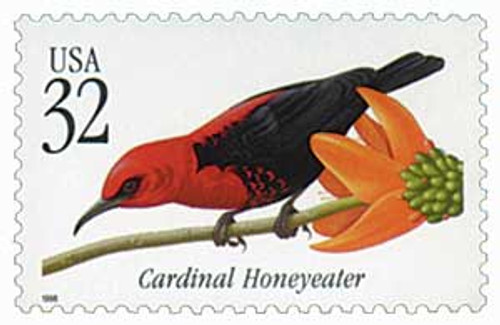
1998 32c Cardinal Honeyeater Tropical Bird
# 3225 - 1998 32c Cardinal Honeyeater Tropical Bird
$1.00 - $2.95
U.S. #3222
1998 32¢ Cardinal Honeyeater
Tropical Birds
1998 32¢ Cardinal Honeyeater
Tropical Birds
Issue Date: July 29, 1998
City: Ponce, Puerto Rico
Quantity: 17,500,000
Printed By: Banknote Corporation of America
Printing Method: Lithographed
Perforations: 11.2
Color: Multicolored
City: Ponce, Puerto Rico
Quantity: 17,500,000
Printed By: Banknote Corporation of America
Printing Method: Lithographed
Perforations: 11.2
Color: Multicolored
This issue is part of a four-stamp se-tenant featuring tropical birds that are native to the islands belonging to the United States. The Antillean Euphonia resides in the thick mountain forests of Puerto Rico. The Green-throated Carib is also found in Puerto Rico, but along the northeast coast. The Crested Honeycreeper is an endangered species from the rain forests of Maui, and the Cardinal Honeyeater lives on the South Pacific island of Samoa.
A member of about 170 species of birds within the songbird family Meliphagidae, the cardinal honeyeater once made its home in Guam. Now extinct on that island, the bird can be found in American Samoa in the South Pacific Ocean. Other species of the family are found in Australia, New Guinea, Hawaii, and South Africa.
With its long, tube-shaped tongue sporting brush-like edges, the honeyeater is able to extract nectar from flowers. The bird got its name from its habit of drinking nectar from the blossoms of trees and shrubs. It also eats berries, fruits, caterpillars, spiders, and other insects.
Most honeyeaters are greenish or grayish-brown with white or yellow marks on their heads. They range in size from three to 20 inches long. Only a few species of honeyeaters can sing well, with most making harsh, unpleasant sounds.
Honeyeaters have become nearly extinct in the Hawaiian islands. That is because when American and English people settled there, the animals they brought with them killed the birds. The destruction of forests has also contributed to the low number of honeyeaters there. Of the five species that once lived in Hawaii, only one species, the Kauai oo, was known to have survived.
U.S. #3222
1998 32¢ Cardinal Honeyeater
Tropical Birds
1998 32¢ Cardinal Honeyeater
Tropical Birds
Issue Date: July 29, 1998
City: Ponce, Puerto Rico
Quantity: 17,500,000
Printed By: Banknote Corporation of America
Printing Method: Lithographed
Perforations: 11.2
Color: Multicolored
City: Ponce, Puerto Rico
Quantity: 17,500,000
Printed By: Banknote Corporation of America
Printing Method: Lithographed
Perforations: 11.2
Color: Multicolored
This issue is part of a four-stamp se-tenant featuring tropical birds that are native to the islands belonging to the United States. The Antillean Euphonia resides in the thick mountain forests of Puerto Rico. The Green-throated Carib is also found in Puerto Rico, but along the northeast coast. The Crested Honeycreeper is an endangered species from the rain forests of Maui, and the Cardinal Honeyeater lives on the South Pacific island of Samoa.
A member of about 170 species of birds within the songbird family Meliphagidae, the cardinal honeyeater once made its home in Guam. Now extinct on that island, the bird can be found in American Samoa in the South Pacific Ocean. Other species of the family are found in Australia, New Guinea, Hawaii, and South Africa.
With its long, tube-shaped tongue sporting brush-like edges, the honeyeater is able to extract nectar from flowers. The bird got its name from its habit of drinking nectar from the blossoms of trees and shrubs. It also eats berries, fruits, caterpillars, spiders, and other insects.
Most honeyeaters are greenish or grayish-brown with white or yellow marks on their heads. They range in size from three to 20 inches long. Only a few species of honeyeaters can sing well, with most making harsh, unpleasant sounds.
Honeyeaters have become nearly extinct in the Hawaiian islands. That is because when American and English people settled there, the animals they brought with them killed the birds. The destruction of forests has also contributed to the low number of honeyeaters there. Of the five species that once lived in Hawaii, only one species, the Kauai oo, was known to have survived.











